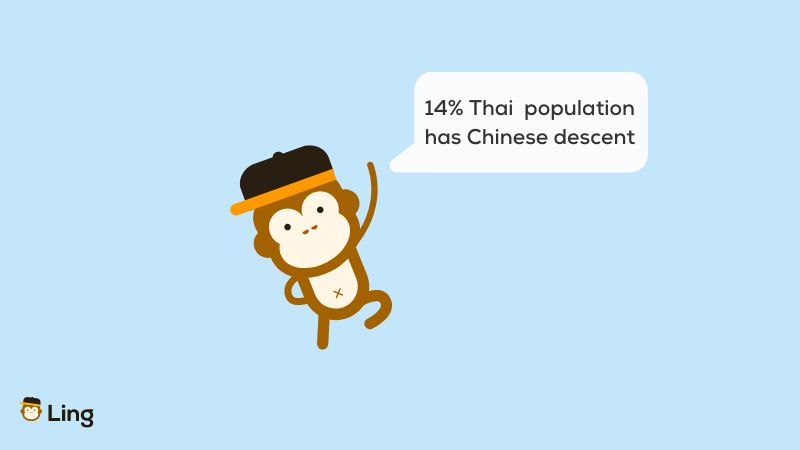Thailand, the “land of smiles,” boasts an amazing culture with roots in Theravada Buddhism. Thai culture has evolved over the centuries with many influences from the Indian subcontinent – mainly Brahminical religion, Europe, and China. Not only traditions, rituals, arts, and literature, but Thai also carries a decent-sized vocabulary from Sanskrit and Chinese languages and the latter’s many dialects. In this post, we’ll get to know these Chinese loan words in Thai so that you can incorporate them into your everyday conversations. Let’s get started!
Chinese Influence On Thailand
As it usually happens, language and food are the two things that get influenced foremost whenever the intermingling of race, religion, or nationality happens. For example, words like Sa-la-bao (steamed buns with pork filling) or Dao-hu (bean curd) are loan words from the Chinese Min Nan dialect. As you can note, Thai words of Chinese origin are already part of everyday vocabulary in many regions of the country.
The most relatable example of Thai words being influenced by the Sino-Tibetan language family is the Thai word for tea. In most of the South East Asian region and the Indian subcontinent, the word for tea is Cha. Its pronunciation in many central and northern parts of India, Pakistan, Bangladesh, and Nepal is Chay (rhyming with the English word buy). In Arabic, the word is pronounced as Shay, while in Persia and Russia, it is pronounced as Chay.
Cha is a Sinitic or Chinese word, meaning it is used across many Chinese dialects. Amusingly, the Thai word for tea is Cha Thai or simply Cha. There are many similar examples where Thai people use loanwords or similar words from other languages.

History Of The Chinese People In Thailand
Thai Chinese is the most significant and integrated community of Chinese origin, having a location outside China. Many present-day Thais trace their ancestry back to their Chinese origins. Today, almost 14% of the Thai population has a Chinese lineage.
The earliest influx began in the 13th century when Chinese traders arrived at the Siamese Kingdom of Ayutthaya. Therefore, Chinese influence on the Thai language and Thai culture has been quite pervasive.
Chinese Migration To Thailand
The first-ever Chinese diaspora arrived in Thailand (or in the historical region of Ayutthaya) in the 13th century. Most of these were the Tai people or people who spoke a common Tai language which belongs to the Tai-Kadai or Kra-Dai language family. Tai-Kadai language family covers Mainland Southeast Asia, Southern China, and Northeast India regions.
In the 1700s, King Taksin The Great – himself of ethnic Tae Chew Chinese descent – facilitated a steady immigration of Chinese traders into the Siam Kingdom, resulting in a teeming Thai Chinese population over centuries. Around four centuries ago, in another huge wave of migration, people from the Guangdong and Fujian regions of China migrated to the coastal areas of Thailand. Most of these Chinese immigrants came looking for greener pastures, married local Thai people, and settled here. And thus began the cultural and linguistic exchange.

Chinese Influence On The Thai Language
The present-day Thai language has a vocabulary teeming with borrowed words, especially from Sanskrit and Pali (ancient Indian languages), French, and Chinese. Other South East Asian languages with medium to heavy Chinese influence are Lao, Khmer, Jingphaw, Shan, etc.
Many Chinese dialects like Min Nan, Tae Chew, Hokkien, Hakka, and Cantonese were brought to Thailand over the centuries, either by land migration or via sea route. Today, Tae Chew is spoken by a large number of the Thai Chinese population as most of the speakers of this dialect came from the Guangdong and Fujian regions via sea.
Chinese Loan Words In Thai Conversation
| English | Thai Word | Chinese Word | Chinese Dialect |
| Three | Sam | Sam | Min Nan |
| Four | Si | Si | Min Nan |
| Seven | Chet | Chit | Min Nan |
| Eight | Baet | Boe | Min Nan |
| Nine | Gao | Gao | Min Nan |
| Ten | Sip | Tzap | Min Nan |
| Eleven | Sip-et | Tzap-it | Min Nan |
| Twenty | Yee-sip | Li-tzap | Min Nan |
| Thirty | Sam-sip | Sa-tzap | Min Nan |
| Forty | Si-sip | Si-tzap | Min Nan |
| Seventy | Chet-sip | Chit-tzap | Min Nan |
| Eighty | Baet-sip | Boe-tzap | Min Nan |
| Ninety | Gao-sip | Gao-tzap | Min Nan |
| Money | Ngen | Ngan | Cantonese |
| Chicken | Gai | Gai | Cantonese |
| Horse | Ma | Ma | Mandarin |
| Don’t have | Mai-iu | Mei-you | Mandarin |
| Tea | Cha | Cha | Mandarin |
| Soap | Sa-bao | Sat-bun | Min Nan |
| False/artificial | Gei | Gei | Min Nan |
| Beautiful | Suai | Sui | Min Nan |
| Chair | Gao-ee | Ee | Min Nan |
| Table | Dtoh | Dtoh | Min Nan |
| Old | Gao | Gao | Min Nan |
| Vegetable | Ce | Cay | Min Nan |
| Already | Liao | Liao | Min Nan |
| This | Anni | Anni | Min Nan |
| Soun/noise | Sia | Sia | Min Nan |
| Beijing | Bak-king | Bak-king | Min Nan |
| Singapore | Sing-ga-po | Sing-ga-po | Min Nan |
| Pork-filled steamed bun | Sa-la-bao | Sa-la-bao | Min Nan |
| Glutinous rice dumplings | Va-tsang | Va-tsang | Min Nan |
| Egg noodle | Bah-mi | Mi | Min Nan |
| Bean curd | Dao-hu | Dao-hu | Min Nan |
| Gelatin bean dessert | Dai-hui | Dai-hui | Min Nan |
As you can see, many Thai words share commonalities with their Chinese counterparts. Loanwords often provide a fascinating window to peep into the evolution of a land’s demographic evolution and its culture’s amalgamation with that of the migrants.

Learn Thai With The Ling App
Did reading about these Chinese loanwords interest you in learning more similarities or differences between borrowed Thai terms and other languages? Then simply download the Ling app from the Google PlayStore and Apple AppStore now, and learn more than borrowed words. This is a great way to make your way towards learning Thai and adding another feather to your linguistic abilities! Chokh dī! (Good luck in Thai.)























